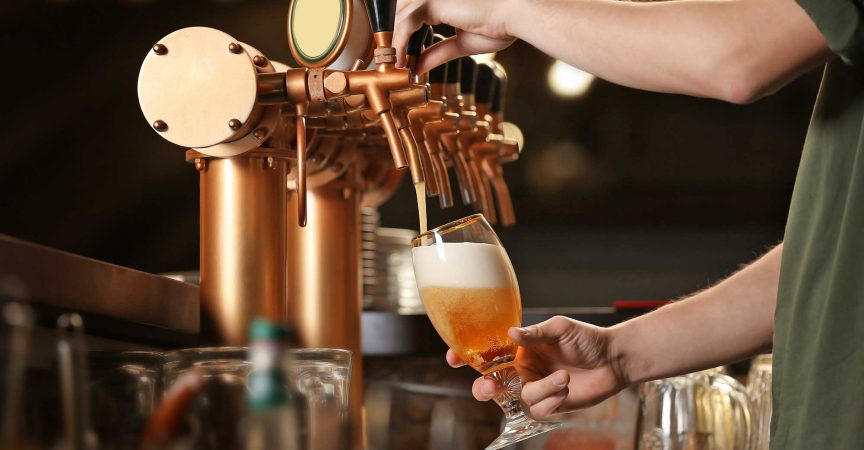5 mistakes bars make when serving beer
Do you want the IPA again?” The bartender asked me. I was at an upscale brewpub in Ontario. “Yes please,” I said, handing her my empty glass. She took it, expertly inverted it over the glass rinser (a circular device that sits below the tap handles and shoots water into the glass) and squeezed down.
And just like that all of my germs and bacteria from the used glass were transferred to that glass rinser—and to every subsequent pint glass of beer that is filled at that bar until the next time they clean that rinser.
There’s a myth that only cheap bars make mistakes with beer—but as an Advanced Cicerone and veteran beer critic, I can tell you that mistakes like this happen in even the most beer-centric joints. Want to check if your restaurant is on point when it comes to great beer service? Read my five mistakes that bars make and then observe your bartenders at work.
Dirty glassware
Here’s a test to check if your glasses are “beer clean.”
Pour beer into a couple of your glasses and check if there are any bubbles clinging to the sides of the glass. Bubbles will only stick to oily residue or dirt, so a “beer clean glass” should have carbonation cascading up the centre of the glass, but no bubbles clinging to the edges.
If your glasses aren’t beer clean, check the following: make sure you’re using restaurant-grade, non-petroleum detergent designed for glassware. Invert your glasses on a perforated rack with good air-flow when drying, and when you use sanitizer, make sure you let the glass fully dry before putting the glasses away—sanitizers need to dry to take effect. Finally, don’t stack glasses, and when you’re ready to serve give your glass a quick cold water rinse before filling to rid it of any leftover sanitizer or dust.
Clean glasses and the proper pour
When a customer comes back and asks for a refill, give them a clean glass. It prevents contamination. Pour slowly down the side of the glass until it is three-quarters full, then straighten the glass and pour down the middle to get a proper head. Just make sure the faucet never touches the glass or the liquid—these are two easy contamination points.
Foamy pints
Beer is foam—when that fluffy white stuff condenses down two-thirds of it turns to liquid beer, so if you’re constantly overflowing your glasses or cutting foam off the top of the beer then you’re literally pouring money down the drain. To get the perfect pour you want first to check that your tap lines are pouring pure liquid beer (no foam) when they’re fully opened. If they’re not, you’ve got an issue with the draft system (likely temperature related), and you need to solve it.
Once you’ve got liquid coming from the taps, make sure to use the right pouring technique. Bartenders should always pour with two hands: one on the bottom of the tap handle, and one on the glass. They should be holding the glass at an angle while pouring liquid down the side, keeping as little space between the glass and the tap as possible to prevent excess foaming. Once the glass is three-quarters full, they should straighten it up to get a full head without overflowing foam into the drain.
Over-ordering
Think of beer as liquid bread, over time it will develop stale flavours through a set of reactions known as oxidation. Hop-forward beers, like IPA’s and Pale Ales, will show degradation first because hop aromas are the first thing to go mute, after that malt flavours will shift, developing sweeter caramel or honey characteristics, then hop bitterness dies off, and finally, papery flavours start to come through.
Warm temperatures speed up these reactions so always keep your beer cold: put kegs and cans right into the beer fridge on delivery. Always check date codes on kegs, bottles and cans when you receive them and send anything back that’s passed, or very close to, code. Order only as much beer as you need for a short period (many of the best beer bars order weekly). Keeping stock low, means you’re keeping beer fresh.
Light it up
Ever opened a green bottle of beer to be greeted with a sulfuric whiff of skunk spray? That’s because hops (which are found in every beer) are light-sensitive, and when fluorescent lights or sunlight strike beer, the hops will produce a skunky odour. This reaction happens in less than a minute. Cans and brown glass block all, or almost all, of the harmful rays, but green and clear beer bottles are extremely sensitive. When storing these beers, it’s essential to keep them out of the light at all times. Even a minute or two in direct light will produce a sulfuric aroma and ruin the nose of the beer. Pro tip: Miller Genuine Draft and Miller High Life are made with a special type of hop product that will not produce this compound.
About the author
Crystal Luxmore is the Canadian Program Representative for the Cicerone Certification Program. When consumers want great beer, they need help from a server who really knows beer flavours, styles, and service. The Cicerone® Certification Program offers independent assessment and certification so that industry professionals—as well as consumers—can be sure of the knowledge and skills possessed by current and prospective beer servers.










The precedent has been set for so many years that it is really hard to change the habits now. I think we should let them carry on as they have been doing for the past so many years.